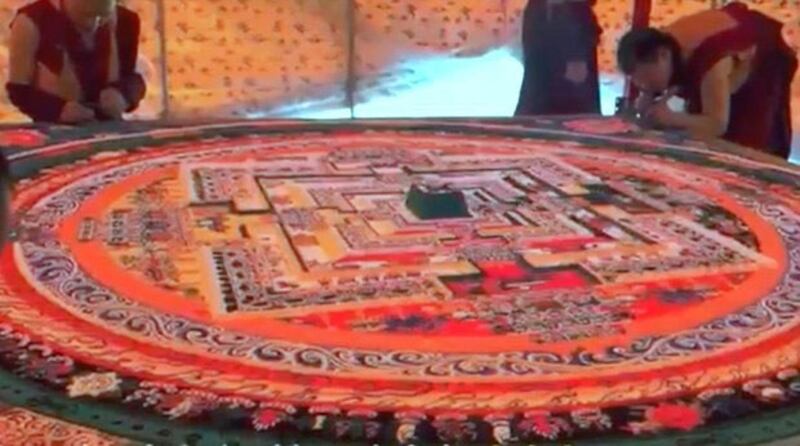UPDATED at 8:01 P.M. EDT on 07-20-2023
Tearing down tents and destroying a colorful sand mandala, Chinese authorities on Wednesday stopped a gathering where a Tibetan Buddhist lama was scheduled to preach – and tried to block online photos and descriptions of the incident, two Tibetans with knowledge of the situation said.
The actions in northwestern China's Qinghai province are the latest efforts by China to suppress Tibetan religious and cultural expressions.
In recent years, authorities have strengthened laws to control the behavior of religious teachers in an effort to curb the spread of Tibetan Buddhist teachings, demolished Tibetan religious sites and closed down religious schools.
Chinese government officials canceled the Kalachakra teaching by Lama Kalsang Tashi Gyatso, abbot of Athi Monastery in Tsolho, or Hainan, Tibetan Autonomous Prefecture’s Mangra (Guinan) county, the sources said. The event was scheduled to begin on Wednesday, the sources said.
“The authorities have erased and wiped out all the related photos and news of the Kalachakra teachings online,” said a Tibetan from inside western China’s Tibet Autonomous Region. “The authorities have also started interrogating those who have already shared news and photos about the Kalachakra.”
They also destroyed the sand mandala, which was specially designed for the event. Sand mandalas are intricate designs made of sand representing a spiritual journey that are used in Tibetan Buddhism as an aid to meditation.

The Kalachakra, which literally means “infinite wheel of time” in Sanskrit, is a sacred event where key Buddhist teachings are passed on to devotees. Only a very few qualified Tibetan Buddhist masters, including the Dalai Lama, the spiritual leader of Tibetan Buddhism, can impart such teachings.
Preparations for Kalachakra teachings can take days to set up because large numbers of devotees come from near and far to attend, said a second Tibetan who lives inside the region.
Organizers paid more than 200,000 yuan (US$27,700) to secure the venue for the event and had already bought food supplies and other necessities that have now gone to waste, said the source, who declined to be named for the same reason.
Tibetans in the region had long appealed to Chinese authorities to grant them permission to organize a Kalachakra teaching by Lama Kalsang Tashi Gyatso, sources said.
“Though Qinghai’s Department of Religious Affairs had already granted permission to organize this Kalachakra teaching, now there are so many Chinese police deployed all over the venue where it was supposed to take place, and people have been forced to leave the premises,” said the first Tibetan source, who declined to be identified so as to speak freely.
The Chinese government canceled a similar event last week where a prominent lama was scheduled to give a Kalachakra teaching in Tsoe, or Hezuo in Chinese, in Gannan Tibetan Autonomous Prefecture, where he was born, though organizers had obtained permission from authorities in advance, RFA reported.
“The local Tibetans are certain that the central Chinese government has instructed the local authorities to curb such large religious gatherings,” said the first Tibetan source. “And this last-minute cancellation of Kalachakra has really disappointed and infuriated devotees who have come from far and nearby areas.”
Translated by Tenzin Dickyi for RFA Tibetan. Edited by Roseanne Gerin and Malcolm Foster.
Adds description of sand mandala.
